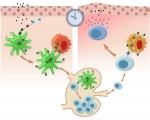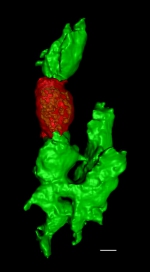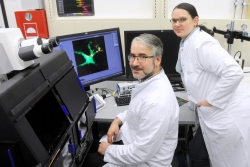Prof. Dr. Peter Mertens
Department of Nephrology, Diabetology and Endocrinology
Prof. Dr. Dimitrios Mougiakakos
Department of Hematology and Oncology
Prof. Dr. Christoph Lohmann
Department of Orthopedics

Researchers from the Health Campus Immunology, Infectiology and Inflammation (GC-I³), which is part of the medical campus of the Otto-von-Guericke University Magdeburg, have shown for the first time that targeted contact occurs between dendritic cells and mast cells in living organisms with exciting functional consequences.
Dendritic cells are important for the innate immune defense that protects the body at borders such as skin and mucosa because they set off the alarm in the immune system. They identify penetrating germs, take them in, and display components of the foreign molecule – the antigens – on their outer surface to other cells of the immune system, the T cells. Through this, T cells are activated, multiply, and start a defense mechanism against the pathogen. Til now, mast cells have been seen primarily as facilitators of undesirable allergic reactions. Recently, researchers including the last author of the study, Prof. Anne Dudeck, who leads the research group for immune regulation at the Institute for Molecular and Clinical Immunology, have been able to show that mast cells also play an important role in the immune response. A completely new mechanism, through which dendritic cells interact with the inflamed skin and carry important molecules for the immune defense, was published by Prof. Dudeck’s team in the Journal of Experimental Medicine.
 The researchers used a series of elegant methods for their experiments. First, they bred mice which produce so-called fluorescence proteins that cause dendritic cells to light up green, whereas mast cells appear red under the microscope. Using this method and intravital multiphoton microscopy, they observed the inflammatory reaction in the skin live and saw how these two types of cells interacted. In order to do more than just observe the cells, a biotechnology expert, Prof. Marc T. Figge, who leads the research group for applied systems biology at the Leibniz Institute for Nature Product Research and Infection Biology in Jena, helped quantify the relationship. He and his coworker, Dr. Anna Medyukhina developed algorithms that allow the automatic analysis of hundreds of interactions between mast cells and dendritic cells.
The researchers used a series of elegant methods for their experiments. First, they bred mice which produce so-called fluorescence proteins that cause dendritic cells to light up green, whereas mast cells appear red under the microscope. Using this method and intravital multiphoton microscopy, they observed the inflammatory reaction in the skin live and saw how these two types of cells interacted. In order to do more than just observe the cells, a biotechnology expert, Prof. Marc T. Figge, who leads the research group for applied systems biology at the Leibniz Institute for Nature Product Research and Infection Biology in Jena, helped quantify the relationship. He and his coworker, Dr. Anna Medyukhina developed algorithms that allow the automatic analysis of hundreds of interactions between mast cells and dendritic cells.
This interdisciplinary analysis had surprising results: before the triggering of the inflammatory reaction, the dendritic cells patrolled through the skin with increased speed and showed no interest in the mast cells, which were evenly and statically distributed in the tissue. When the inflammatory reaction in the skin was triggered, they changed their behavior dramatically. After a few minutes, they stopped moving and remained in position for hours. Then they became mobile again and started to have contact with the stationary mast cells and simultaneously formed close and durable contact with them.
 The most surprising observation was that this close contact between the dendritic cells and the mast cells resulted in transfer of material from the first to the latter. Around 18 hours after the triggering of the reaction, the inside of the red mast cells had visible green regions that came from the dendritic cells. The scientists found out that these also included MHC-Class II molecules, which the dendritic cells need in order to present antigens to T cells on the cell surface. After the transfer, the mast cells were suddenly able to stimulate T cells, which is normally the main job of the dendritic cells. DCs however have to migrate to the lymph nodes in order to fulfill this function while the mast cells remained in the skin. Jan Dudeck, one of the two first authors of the study emphasizes the relevance of this discovery: “Our theory is that the newly observed mechanism makes sure that the dendritic cells don’t leave the tissue unguarded. Instead they give their ‘weapons’ to the mast cells so that they can fulfill the function of activating the T cells while the dendritic cells are gone.”
The most surprising observation was that this close contact between the dendritic cells and the mast cells resulted in transfer of material from the first to the latter. Around 18 hours after the triggering of the reaction, the inside of the red mast cells had visible green regions that came from the dendritic cells. The scientists found out that these also included MHC-Class II molecules, which the dendritic cells need in order to present antigens to T cells on the cell surface. After the transfer, the mast cells were suddenly able to stimulate T cells, which is normally the main job of the dendritic cells. DCs however have to migrate to the lymph nodes in order to fulfill this function while the mast cells remained in the skin. Jan Dudeck, one of the two first authors of the study emphasizes the relevance of this discovery: “Our theory is that the newly observed mechanism makes sure that the dendritic cells don’t leave the tissue unguarded. Instead they give their ‘weapons’ to the mast cells so that they can fulfill the function of activating the T cells while the dendritic cells are gone.”
Prof. Dudeck, who joined the Institute for Molecular and Clinical Immunology last year, praises Magdeburg: „The imaging expertise and the equipment used here at the Health Campus GC-I³ are critical, without it these studies would not be successful.” She has many plans for the future and says “It is extremely exciting to observe the immune cells in real time as they work and communicate. It is always fascinating to see how elegant and efficient the strategies of the immune system of an organism are against attacks from outside. The current question we are working on is whether this intercellular communication also goes in the other direction, so that the dendritic cells learn something from the mast cells.” These insights into the communication between immune cells could be used in therapy in the future, for example in order to support the defensive forces or to regulate an excessive inflammatory reaction.
Figure 1: Graphic summary of the new insights: Mast cells are given the new ability to display antigens by dendritic cells. During the course of an inflammatory reaction, a direct interaction occurs between the dendritic cells (green) and the mast cells (red) in the skin. Dendritic cells transfer MHC-Class II complexes to the mast cells before leaving for the lymph nodes to expand specific T cells. The mast cells remaining in the skin are thus weaponized so that they can activate T cells as soon as they move to inflamed regions of the skin. Through these strategies, the dendritic cells fulfill their role in the lymph nodes while still completing their job at the location of inflammation.
Figure 2: Dynamic interaction between dendritic cells and mast cells. Intravital multiphoton microscopy of a dendritic cell (green) and a mast cell (red) during an inflammatory reaction in the skin. The mast cell receives intracellular vesicles (yellow) with a green fluorescent protein from the dendritic cell.
Figure 3: Prof. Dr. Anne Dudeck and Jan Dudeck in front of the multiphoton intravital microscope. This technology was critical to the discovery described above.
Text: Dr. Martina Beyrau
Prof. Dr. Peter Mertens
Department of Nephrology, Diabetology and Endocrinology
Prof. Dr. Dimitrios Mougiakakos
Department of Hematology and Oncology
Prof. Dr. Christoph Lohmann
Department of Orthopedics
Last Modification: 09.11.2020 - Contact Person: